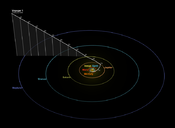Template:Are You Sure/February 14: Difference between revisions
(Created page with "File:Voyager 1 flight diagram - Pale Blue Dot position (14 February 1990).png|thumb|175px|link=Pale Blue Dot (nonfiction)|Position and trajectory of Voyager 1 and the positi...") |
No edit summary |
||
| Line 2: | Line 2: | ||
• ... that '''''[[Pale Blue Dot (nonfiction)|Pale Blue Dot]]''''' is a photograph of planet Earth taken on February 14, 1990, by the [[Voyager 1 (nonfiction)|Voyager 1]] space probe as part of the ''Family Portrait'' series of images of the Solar System, and that Voyager 1, which had completed its primary mission and was leaving the Solar System, was commanded by NASA to turn its camera around and take one last photograph of Earth across a great expanse of space at the request of astronomer and author [[Carl Sagan (nonfiction)|Carl Sagan]]? | • ... that '''''[[Pale Blue Dot (nonfiction)|Pale Blue Dot]]''''' is a photograph of planet Earth taken on February 14, 1990, by the [[Voyager 1 (nonfiction)|Voyager 1]] space probe as part of the ''Family Portrait'' series of images of the Solar System, and that Voyager 1, which had completed its primary mission and was leaving the Solar System, was commanded by NASA to turn its camera around and take one last photograph of Earth across a great expanse of space at the request of astronomer and author [[Carl Sagan (nonfiction)|Carl Sagan]]? | ||
• ... that physicist '''[[Owen Willans Richardson (nonfiction)|Owen Willans Richardson (nonfiction)|Owen Willans Richardson]]''' won the Nobel Prize in Physics in 1928 for his work on thermionic emission, which led to Richardson's law, and that Richardson also researched the photoelectric effect, the gyromagnetic effect, the emission of electrons by chemical reactions, soft X-rays, and the spectrum of hydrogen? | |||
Revision as of 18:29, 14 February 2020

Voyager was 6 billion kilometers (3.7 billion miles, 40.5 AU) from the Earth, a record distance for data transmission.
• ... that Pale Blue Dot is a photograph of planet Earth taken on February 14, 1990, by the Voyager 1 space probe as part of the Family Portrait series of images of the Solar System, and that Voyager 1, which had completed its primary mission and was leaving the Solar System, was commanded by NASA to turn its camera around and take one last photograph of Earth across a great expanse of space at the request of astronomer and author Carl Sagan?
• ... that physicist Owen Willans Richardson (nonfiction)|Owen Willans Richardson won the Nobel Prize in Physics in 1928 for his work on thermionic emission, which led to Richardson's law, and that Richardson also researched the photoelectric effect, the gyromagnetic effect, the emission of electrons by chemical reactions, soft X-rays, and the spectrum of hydrogen?